树突状细胞培养与鉴定
猪骨髓树突状细胞的体外扩增及鉴定
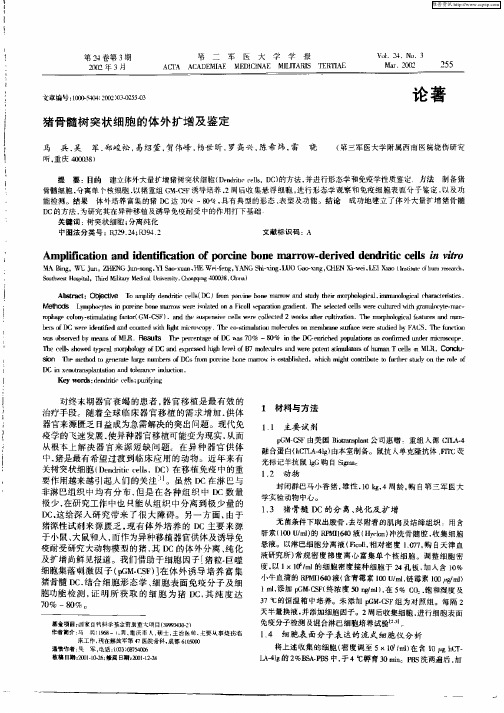
eel o, qel oro g f Cadepe e i l eo 7m l u s n  ̄e o nsm a ro m n l L . o d ・ es h ̄ dt ̄ am r l y n xrs dh曲 e l f oe l d , t tt u ts f u a c l i M R C n u s e 3i  ̄ o o D s v B c e a v r p e il o h e T e sn
Ⅵ^ Bn , ig J n HE G u ・og. So xa , u ,Z N Jnsn Ⅵ a ・ un HEW e e g  ̄ NG S id g L M n ,' A h- n ,UO G oxn , HE X - e, E Xio[ntm f : a -Jg C N iw iL I a Isteo l —
ae fao . t e f r u vf n l i r rtl iaf t e adIn n l o c]e u s n Ul oa g  ̄ a r 1  ̄
。 c o)sm an c rG C F . n esses ecl te oet w u n- i ̄ tgf l ( M—S j adt upni esW F clc d 地 l t i ao h v l  ̄ l e 2 q
w o sne v be , b d o R R咖 I fML t s p re t eo ecna fX; g I
b t o C w ie f da dcu td t gt cocp T ee-t l i ̄moeIe lme | BsraeWbesuidb A S T efn t n es f 哪 d l n o ne hl h rsoy h os mua o D e i mi i t l 1 so mb锄 uf t tde yF C . h ci cI 3 o  ̄ u o 7 % 一8 % i eD er hd pp lt n s∞ ni du drm cocp . 0 o nt 0 ni e o uai sa h c o fme n e irso e r
分泌IFN-γ的杀伤性树突状细胞的体外诱导培养及鉴定

( p.fE i oyadI Deto t l n og mmu o g ,Me i l c olfY t h uU i r t, nl y o dc h o o wg o nv s y aS z ei
Ya g h uJa g u 2 5 01 C ia n z o in s 2 0 , h n )
c ln — t lt g fco ( mGM— F a d nelu i (I ) 一 n i o A d y 6, l 0 0ya c aiP oo y si ai a tr r mu n CS ) n itr kn e L 4 i vt . t a i p 1sc h r1 r p (
( P ) w sa d d t rmoeDCs mauain a d df rnit n Atd y 7, CD1 c 2 0NK11 el w r LS a d e o po t ’ trt n i ee t i . a o f ao B 2 l . c l ee s
钱 莉 ,陆家辉 ,潘兴元 ,田芳 ,龚卫娟 ,季明春
( 州大 学 医学院病原 生物 学与 免疫 学教研 室,江 苏 扬 州 25() 扬 20) 1
[ 摘要] 日的 从体 外诱导 的骨髓来源的树 突状细胞 (edi l ,D )中分离分泌 IN 的杀伤性树 d n ri c l C t es c F一
a por t cnuae A .F r emo .C 1 2 0N 1 c l e i uae i F tm r e s p rpi e ojgt m b u hr r a d t e D B 2 K1 e s r s m lt w t B o l 1 cw l . lw e t d h 1 1 u cl 6 0
树突状细胞实验报告

一、实验目的1. 了解树突状细胞(Dendritic Cells,DCs)的基本特性及其在免疫调节中的作用。
2. 掌握DCs的分离、培养和鉴定方法。
3. 学习利用DCs进行免疫调节实验。
二、实验原理树突状细胞是机体免疫系统中重要的抗原提呈细胞,具有摄取、加工和呈递抗原的能力。
DCs在启动、调控和维持免疫应答中发挥着关键作用。
本实验通过分离、培养和鉴定DCs,探讨DCs在免疫调节中的作用。
三、实验材料1. 试剂:胎牛血清、RPMI 1640培养基、DMEM培养基、双抗、TNF-α、IL-4、抗鼠CD14抗体、FITC标记的羊抗鼠IgG抗体等。
2. 仪器:CO2培养箱、倒置显微镜、流式细胞仪等。
四、实验方法1. DCs分离与培养(1)取健康小鼠脾脏,置于DMEM培养基中,剪碎后用200目筛网过滤。
(2)将滤液加入含10%胎牛血清的RPMI 1640培养基,在37℃、5%CO2条件下培养。
(3)培养3天后,加入TNF-α和IL-4,继续培养至第7天。
2. DCs鉴定(1)收集培养的细胞,用抗鼠CD14抗体进行标记。
(2)用FITC标记的羊抗鼠IgG抗体进行二次染色。
(3)流式细胞仪检测细胞表面CD14的表达情况。
3. 免疫调节实验(1)将分离得到的DCs与抗原共同培养,观察DCs对抗原的摄取和呈递能力。
(2)将DCs与T细胞共同培养,观察DCs对T细胞的激活作用。
五、实验结果1. DCs分离与培养:培养7天后,观察到细胞形态呈树突状,符合DCs的形态特征。
2. DCs鉴定:流式细胞仪检测结果显示,细胞表面CD14的表达率为(95±3)%,说明成功分离出DCs。
3. 免疫调节实验:(1)DCs对抗原的摄取和呈递:在抗原刺激下,DCs能够摄取并呈递抗原,说明DCs具有抗原摄取和呈递能力。
(2)DCs对T细胞的激活作用:在DCs与T细胞共同培养条件下,观察到T细胞增殖,说明DCs具有激活T细胞的作用。
树突状细胞的体外培养及鉴定
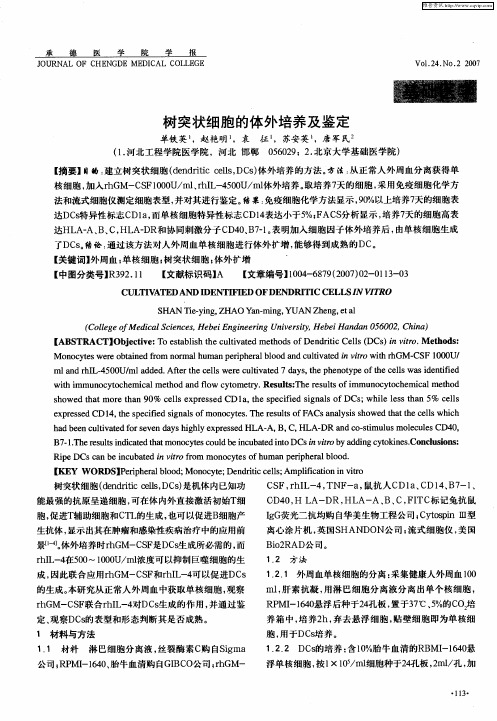
【 关键 词】 外周 血 ; 核细 胞 ; 突状 细胞 ; 外扩增 单 树 体
【 中图分类号1 3 2 1 R 9.l
【 文献标பைடு நூலகம்码】 A
【 文章编号】04 6 7 (07 0- 13 0 10 - 892 0 )2 0 - 3 l
CI II TE AND I T、 D DENTⅡ D oFDEN RI C D TI CELLSI V T N I RO
(. 1河北 工程 学院 医学 院 ,河北 邯郸
0 62 ;2 北 京大 学基 础医 学院 ) 5 09 .
【 摘要】 目的: 建立树突状细胞 (ed iccl , s体外培养的方法。 dn r i e sDC ) t l 方法: 从正常人外周血分离获得单
核细 胞 , 入r G 加 h M—C Fl 0 U/n 、h L 4 0 U/ 体 外培 养 。 培养 7 的细胞 , S 0 0 rlr l - 5 0 ml 取 天 采用 免疫 细胞化 学方 法和流 式细胞仪 测定细胞表 型 , 并对其 进行鉴 定。 结栗 : 免疫细 胞化 学方 法显示 ,0/ 9  ̄以上 培养7 的细胞表 , 0 天
M o o y e r b a n d f o n r l u np rp e a l o n u t a e n vto wi GM - F 1 0 U/ n c ts we eo t i e m o ma ma e h r l o d a dc l v td/ i t r r h i b i r h h CS 0 0
维普资讯
丞 堡 医
堂
堂 塑
VO . 4 No. 2 0 12 . 2 07
J 0URNAL OF HE C NGDE M E CAL COL GE DI LE
树突状细胞培养方法

树突状细胞培养方法树突状细胞(Dendritic Cells,DCs)是一类免疫细胞,主要负责识别和激活T细胞,发挥着重要的免疫调节和抗肿瘤等作用。
为了进行树突状细胞的研究,科研人员需要对其进行体外培养。
本文将介绍常用的树突状细胞培养方法。
1.制备树突状细胞前驱细胞:树突状细胞前驱细胞主要存在于外周血和骨髓中。
首先,采集外周血或骨髓,并将其进行红细胞裂解。
然后,用PBS洗涤样品,离心沉淀细胞。
最后,将细胞进行培养。
2.培养基的选择:培养树突状细胞需要选择适宜的培养基。
目前常用的培养基有RPMI1640、DMEM等。
添加10-20%的胎牛血清(FBS)可以提供必要的生长因子和营养物质。
3.添加生长因子:在培养树突状细胞的过程中,可能需要添加一些生长因子来促进细胞的分化和增殖。
常见的生长因子包括GM-CSF(粒细胞巨噬细胞集落刺激因子)和IL-4(白细胞介素4)。
可以将这些生长因子添加到培养基中,以达到最佳生长条件。
4.细胞培养条件的控制:树突状细胞对培养条件非常敏感。
因此,需要对温度、湿度、CO2浓度等参数进行严格控制。
一般来说,将细胞培养在37摄氏度、5%CO2的培养箱中。
5.细胞的分离和传代:在树突状细胞培养过程中,细胞会不断增殖。
为了保证细胞的活力和稳定性,需要定期分离和传代细胞。
可以使用胰酶等消化酶将细胞从培养瓶中剥离,然后进行细胞计数并按照一定比例进行传代。
6.细胞质量的评估:在培养树突状细胞的过程中,需要对细胞质量进行评估。
可以通过使用流式细胞仪等设备来检测细胞表面标记物的表达情况,以及细胞活力、树突状突起的形态等指标来评估细胞的质量。
7.树突状细胞的激活:树突状细胞的主要功能是激活T细胞。
为了使树突状细胞具备充分的抗原递呈能力,可以使用多种促进细胞激活的方法,如脂多糖、TNF-α等。
总结:树突状细胞培养方法包括制备前驱细胞、培养基选择、生长因子添加、细胞培养条件控制、细胞分离和传代、细胞质量评估以及细胞的激活等步骤。
小鼠骨髓源树突状细胞的体外培养及鉴定

源 的未 成 熟 和 成 熟 D C.
[ 关键词]树突状细胞 ;小 鼠;近交系 ;骨髓 细胞 ;吞 噬作用
[ 中图分类号]R 3 2 2 . 2[ 文献标识码]A [ 文章编号]2 0 9 5 -6 1 0 X ( 2 0 1 3 )1 1 -0 0 0 5 -0 4
Cu l t i v a t i o n a nd I de nt i ic f a t i o n o f De nd r i t i c Ce l l s f r o m Mo us e Bo ne Ma r r o w i n Vi t r o
W ANG 一 y i n”, CHEN Ru i ”, W ANG J u n ,S U Xi a o — s a n”, Z HANG L e i ”
( 1 )B i o m e d i c a l R e s e a r c h C e n t e r ,T h e A f il f i a t e d C lm a e t t e Ho s p i t l a o fKu n mi n g Me d i c a l U n i v e r s i t y ,Ku n mi n g Y u n n a n 6 5 0 0 1 1 ; 2)D e p t . fA o n e s t h e s i o l o g y ,T he I s t A f il f i t a e d Ho s p i t a l fK o u n m i n g Me d i c a l U n i v e r s i t y , Kt mmi n g Y u n n a n 6 5 0 0 3 1 ,C h i n a ) [ Ab s t r a c t ] Ob j e c t i v e T o e s t a b l i s h a me t h o d o f c u l t i v a t i o n o f d e n d r i t i c c e l l s( DC ) f r o m mo u s e b o n e m a r r o w
小鼠骨髓来源树突状细胞(BMDC)培养

小鼠骨髓来源树突状细胞(BMDC)的培养1、取骨髓,对倍稀释2、用滴管沿管壁缓慢加入淋巴细胞分离液(45度角倾斜,尽量产生气泡,起到缓冲作用)3、2000转,离心30分钟4、吸取白膜层,(沿管壁)交替多次吸取,加入5倍体积以上的PBS液5、1500转,离心15分钟(洗掉血小板)6、弃掉上清,留少许回流液,轻弹管壁,加入PBS液至50ml7、800转,离心10分钟,(洗掉红细胞)8、重复两至三次9、加入PBS液至50ml,计数:?个细胞离心后铺板,1X1076孔板培养液,共铺20板。
无血清1640+DNA酶12h后轻晃培养液,洗板后加入完全培养基和GM—CSF(1000U/ml)和IL—4(500U/lml) 10、第三天每孔补加等体积的完全培养基和GM—CSF(1000U/ml)和IL—4(500U/lml) ,这时细胞部分悬浮11、第五天为imDC,+1LPS(1ug/ml),诱导至第七天,为mDC。
参考Inaba等人的方法,并根据本实验室的经验稍作改进。
即:1. 颈椎脱位法处死C57BL/6小鼠,无菌状态下取股骨和胫骨,浸泡在RPMI-1640培养基中。
2. 用1ml注射器吸取RPMI-1640培养液,从骨干的一端刺入骨髓腔,将骨髓冲洗到一无菌培养皿中,每根骨头反复4~6遍,收集培养皿中的骨髓细胞悬液,离心,1500 rpm×10min。
3. 弃去上清,加入5 ml无菌Tris-NH4Cl溶液悬浮细胞溶解红细胞,于室温下静置2分钟溶解红细胞后,再次离心,1500 rpm×5min,弃上清。
4. 用RPMI-1640培养液洗涤后将细胞用完全培养基悬浮,分至6孔培养板中,并在每孔中加入完全培养基至4 ml,再加入rmGM-CSF至终浓度10 ng/ml,IL-4终浓度10ng/ml。
5. 将细胞培养板放入37℃,含5% CO2的孵箱中培养48小时。
6. 轻轻吹打细胞后,连同培养液一起吸去悬浮细胞,仅保留贴壁细胞。
小鼠树突状细胞(DC)培养

8.加入树突细胞培养液重悬细胞,调整细胞数至1×106/ml(Scepter自动细胞计数器,美国Millipore公司),按2ml/孔接种至12孔细胞培养板(4.5cm2/孔),置37℃、5%CO2孵箱培养。
9.于培养第3,5天每孔分别更换2ml树突细胞培养液。第6天收集悬浮细胞,流式抗体染色后,流式细胞仪检测树突状细胞的表型。
1.4.4 红细胞裂解液pH7.2(1L):
NH4CL 8.56g
Tris碱 2.059g
MilliQ水定容至1L 调节pH至7.2
1.处死BALB/c小鼠并浸泡于75%医用酒精10min,随后取小鼠股骨及胫骨并用眼科剪剔除附着在骨骼上的肌肉。
2.剪掉两侧股骨头,将吸满PBS缓冲液的注射器针头插入骨腔中,并缓慢推动注射器冲洗骨髓腔,直至骨变白。
3.将收集到的骨髓细胞悬液500×g离心5mim,弃上清。
4.向骨髓细胞沉淀中加入红细胞裂解液并反复吹打混匀,置37℃孵箱孵,吸弃上清。用PBS重悬细胞沉淀,200钼铜网过滤除去骨髓细胞悬液中组织碎块。
6.用1ml PBS缓冲液重悬细胞,加入功能纯化抗体抗-小鼠CD4/CD8a/ MHC-Ⅱ/CD45R及兔血清补体,37℃孵育1h,以去除T淋巴细胞、B淋巴细胞及MHC-Ⅱ+细胞。(功能纯化抗体抗-小鼠 CD4(L3T4)、CD8a(Ly-2)、CD45R(B220)、MHC-Ⅱ(I-A/I-E)抗体购自eBioscience公司)
小鼠骨髓及脾脏来源的树突状细胞培养及鉴定
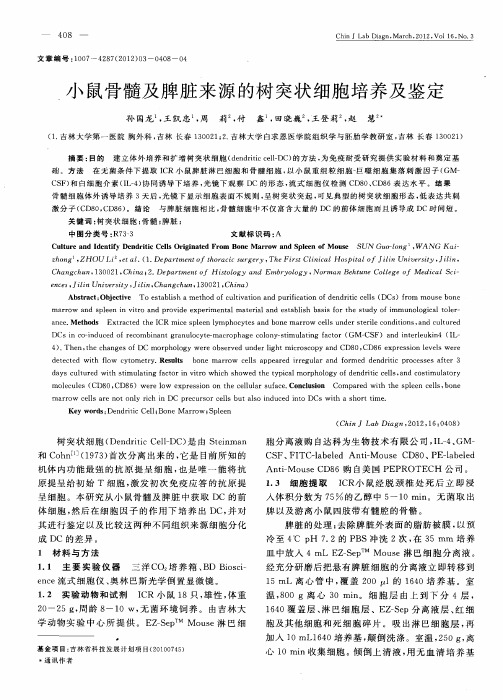
C F 和 白细 胞 介 素 (L 4 协 同 诱 导 下 培 养 , S) I- ) 光镜 下 观 察 D 的 形 态 , 式 细 胞 仪 检 测 C 8 、 D 6表 达 水 平 。结 果 C 流 D 0C 8 骨髓 细 胞 体 外 诱 导 培 养 3天 后 , 镜 下 显 示 细 胞 表 面 不 规 则 , 树 突 状 突 起 , 光 呈 可见 典 型 的 树 突 状 细 胞 形 态 , 表 达 共 刺 低 激分 子 ( D 0C 8 ) C 8 , D 6 。结 论 与 脾 脏 细 胞 相 比 , 髓 细 胞 中不 仅 富 含 大 量 的 DC的 前 体 细 胞 而 且 诱 导 成 DC时 间 短 。 骨 关 键 词 : 突状 细 胞 ; 髓 ; 脏 ; 树 骨 脾
d t c e wih fo ee td t l w c t y ome r t y.Re u t bo m a r s ls ne row c ls pp a e ir gulr a or e n ii pr e s s a t r e l a e r d r e a nd f m d de drtc oc s e fe 3
m ar row n p e n i ir nd p o d xp i e a a e ila d e t b ih ba i o h t a d s l e n vt o a r vie e erm nt lm t ra n s a ls ss f r t e s udy ofi m u m nolgia olr o c lt e — a e M e h s Ex r c e heI ne . t od t a td t CR ie s e n [ m p e t sa on a r w e l nd rs e i o iins, d c t r d m c ple y ho y e nd b e m r o c ls u e t rl c nd to e an ulu e
小鼠肺间质树突状细胞的分离、纯化与鉴定

B L / 小 鼠肺组织经 I A Bc 型胶原酶消化 、 密度梯度离心 、D l 免疫磁珠分选纯化 D s流式细胞术鉴定分选 D s C 1c C, C 纯度 , 倒置相 差显微 镜观察孵 育细胞生长状态 , 扫描 电镜和透射 电镜观察 D s C 超微形态 , 流式细胞术 检测肺 间质 D s C 1cC 1bC 8 C 的 D l、 D l 、D 6 和 I 表型。结果 : 一 分选获得 的肺问质 D s C 经鉴定 , 纯度 为 9 .9 ±5 6 %, R MI 4 培养基 中生长状态 良好 , 25% .2 在 P 10 6 少数 细胞 形成小 细胞集落 。D s C 超微形 态观 察显 示细胞 表 面多见 长 1 a 集 的树枝 状 突起 , 胞器 不 发达 , ~2b 密 m 细 细胞 核 形不 规则 。 9 %以上肺间质 D s o C 为未成熟状态或前体 D s低表达成熟标 志物 I b C 8 , C, . 和 D 6 并具 有异质性 , 4 %起源 于髓 系细胞分化 。 A 近 0
中 国 免疫 学 杂 志 2 1 年 第 10 —8 X.0 1 0 . 1 o:0 3 6 / . s .0 04 4 2 1 .9 0 2 s
・
免疫 学 技术 与 方法 ・
小 鼠肺 间质 树 突 状细 胞 的分 离 、 纯化 与鉴 定①
王 宏伟 陆 江 阳 田 光② 刘 茜 赵 敏 杨 毅 康 佳 蕊
( 解放 军 总 医院第 一附属 (0 ) 34 医院病 理科 , 京 10 4 ) 北 0 0 8
中国图书分 类号 R6. 347 文献标识码 A 文章编号 10.8X(010.840 0044 2 1 )90 1. 5
[ 摘
要 ] 目的 : 建立肺间质树 突状细胞( C ) D s的分离 与纯 化方法 , 为肺 间质 D s C 的相关 研究提供实验基 础。方法 : 性 雄
人外周血富集白细胞层来源的树突状细胞的培养与鉴定
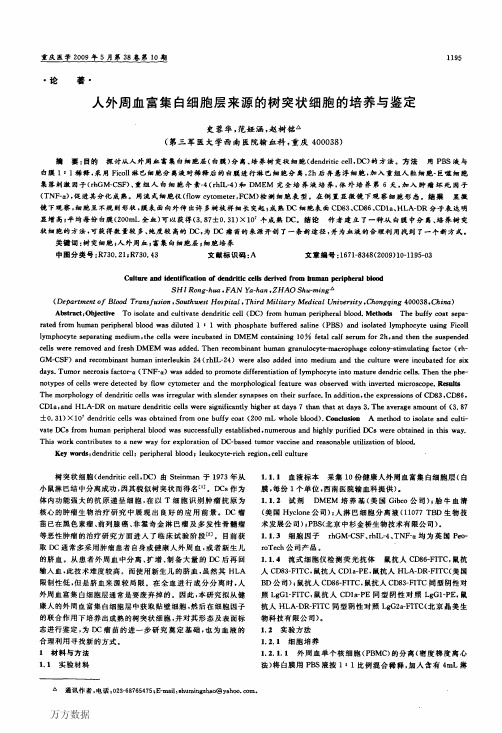
万方数据1196巴细胞分离液的15mL试管中,用吸管取6mL稀释的细胞悬液,在分层液上lcm处。
沿试管壁缓慢加入。
移至离心机中,水平室温,2000r/rain,离心20min离心后管内由上至下分为血浆、单个核细胞、淋巴细胞分离液、红细胞4个带;吸取单个核细胞层,移入另一试管中,加3~4倍PBS,混匀,以1000r/rain,离心10rain,PBS洗细胞2次;800r/rain,离心5min,PBS洗细胞2次。
将离心收集后外周血单个核细胞放于25cm2培养瓶内,加入含10%胎牛血清的DMEM培养基,于37℃、5%COz浓度孵箱内培养静置2h,可见分为黏附于瓶壁的细胞和非黏附细胞。
吸出非黏附细胞,冻存备用。
1.2.1.2DC细胞的诱导培养贴壁的黏附细胞加入含10%胎牛血清的DMEM培养基5mL,调整细胞浓度为2×106个/mL,加入细胞因子rhGM-CSF及rhlL-4,使其终浓度为200ng/mL及100ng/mL.然后置37"C、5%C02孵箱内培养,培养72h追加1次,培养6d后加入细胞因子TNF-a,以促进DC成熟。
1.2.2细胞的形态观察倒置显微镜下每天观察培养中的IX;的细胞数目、形状、外观、生长状况等。
1.2.3DC免疫表型检测采用直接免疫荧光染色法,在流式细胞仪上检测分析。
分别取第3天、第7天培养的DC.PBS液,1000r/min,5min离心洗涤1次,弃上清;PBS重悬细胞,调整细胞浓度为1×106个/mL,加入EP管,每管S00肛L,然后分别加入20/zL单克隆抗体CD86、HLA-DR、CD63、CDla以及10“L各单克隆抗体的同型阴性对照,常温避光保存30rain,用PBS液洗涤两遍,洗去多余的抗体,流式细胞仪(BD,美国)检测。
1.2.4成熟DC的数量取成熟13(2的混悬液10/tL放置在倒置显微镜下计数。
按照公式:计数的个数(109L)X103×混悬液的体积(mL)=成熟IX;的个数/每份白膜.1.3统计学方法所得数据取平均值,以j士s表示,采用SPSSl0.0统计程序进行统计分析I均数的比较用配对t检验分析,P<0.01为差异有统计学意义。
大鼠骨髓来源树突状细胞的分离、培养及鉴定

c l rdD s x rse X 2 ( e re t C ) n ot aueD s x rse ao i 00 p t it ut e C pesd0 6 t kr f a D s ,a dm s m tr C pesdm jr s c m ai ly u e h ma or e ht b i
髓细胞诱导 D C及其培养 、纯化 的方法 ,为下一 步 的研 究提供 基 础 .
Hopt u mig u m n u n 5 0 ,C ia s i l K n n ,K n igY n a 6 0 1 ao f n 1 hn )
[ bat Obe t e T xlr tosf sl i , clr ga d ieti t go a bn A s c] r jci oepoeme d o i an v h r o t g ut i n dnic i frt oe un fan
Z HANG S e g— nn ”, L i , RAN Ja g—h a”, S h n ig I L in u HAO J n c u , L h i - h n a I u”, L U Jn ’ Z I ig‘
()D p.fN . p tblr acet ugr; 2)D p.fTsn aoao ,Te1t epes 1 eto o Hea iayP nracS rey o i i eto etgLbr r i t y h s Pol’
[ 键 词 ] 大 鼠 ;树 突状 细 胞 ;骨 髓 关
[ 中图分类号]R 9 . [ 321 文献标识 码]A [ 文章编号] 10 — 7 6 (0 8 2— 0 1 4 0 3 4 0 20 )0 0 4 —0
I ol i s at on, Cul ur nd de i c t on tBone t ea I nt f a i i ofRa M a r w . r ved e ro . . de i D ndr t c Ce l i i ls
奶牛外周血树突状细胞体外诱导培养与鉴定
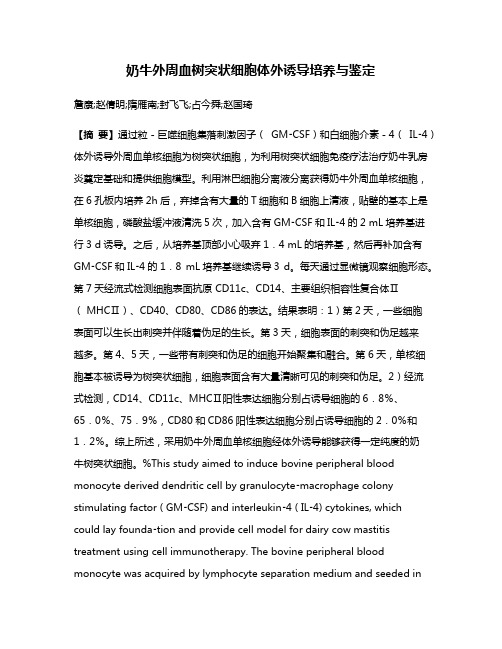
奶牛外周血树突状细胞体外诱导培养与鉴定詹康;赵倩明;隋雁南;封飞飞;占今舜;赵国琦【摘要】通过粒-巨噬细胞集落刺激因子(GM⁃CSF)和白细胞介素-4(IL⁃4)体外诱导外周血单核细胞为树突状细胞,为利用树突状细胞免疫疗法治疗奶牛乳房炎奠定基础和提供细胞模型。
利用淋巴细胞分离液分离获得奶牛外周血单核细胞,在6孔板内培养2h后,弃掉含有大量的T细胞和B细胞上清液,贴壁的基本上是单核细胞,磷酸盐缓冲液清洗5次,加入含有GM⁃CSF和IL⁃4的2 mL培养基进行3 d诱导。
之后,从培养基顶部小心吸弃1.4 mL的培养基,然后再补加含有GM⁃CSF和IL⁃4的1.8 mL培养基继续诱导3 d。
每天通过显微镜观察细胞形态。
第7天经流式检测细胞表面抗原 CD11c、CD14、主要组织相容性复合体Ⅱ(MHCⅡ)、CD40、CD80、CD86的表达。
结果表明:1)第2天,一些细胞表面可以生长出刺突并伴随着伪足的生长。
第3天,细胞表面的刺突和伪足越来越多。
第4、5天,一些带有刺突和伪足的细胞开始聚集和融合。
第6天,单核细胞基本被诱导为树突状细胞,细胞表面含有大量清晰可见的刺突和伪足。
2)经流式检测,CD14、CD11c、MHCⅡ阳性表达细胞分别占诱导细胞的6.8%、65.0%、75.9%,CD80和CD86阳性表达细胞分别占诱导细胞的2.0%和1.2%。
综上所述,采用奶牛外周血单核细胞经体外诱导能够获得一定纯度的奶牛树突状细胞。
%This study aimed to induce bovine peripheral blood monocyte derived dendritic cell by granulocyte⁃macrophage colony stimulating factor ( GM⁃CSF) and interleukin⁃4 ( IL⁃4) cytokines, which could lay founda⁃tion and provide cell model for dairy cow mastitis treatment using cell immunotherapy. The bovine peripheral blood monocyte was acquired by lymphocyte separation medium and seeded in6⁃proe plate to culture for 2 h. Then, suspended cells containing an amount of B and T cells were discarded, and adherent cells were mostly monocyte. The cells were washed for 5 times using phosphate buffer, and 2 mL culture medium containing GM⁃CSF and IL⁃4 cytokines was added to culture for 3 d. After that, 1.4 mL culture medium was discard from medium top, and 1.8 mL culture medium containing GM⁃CSF and IL⁃4 was added to culture for another 3 d. The cell was observed under microscope every day. On days 7, the cells were harvested to detect CD11c, CD14, major histocompatibility complex Ⅱ ( MHCⅡ) , CD40, CD80 and CD86 molecules by flow cytome⁃try. The result showed as follows:1) on days 2, some of the cells started to extend spikes and accompanied by pseudopodia stretching. On days 3, the spikes and pseudopodia grew more and more. On days 4 and 5, cells with spikes and pseudopodia started aggregation and fusion. On days6, most of monocytes were derived to den⁃dritic cells, on which plenty of spikes and pseudopodia could be clearly seen. 2) CD14, CD11c, MHCⅡ, CD80 and CD86 positively expressed cells accounts for 6. 8%, 65. 0%, 75. 9%, 2. 0% and 1. 2% of induced cells by flow cytometry, respectively. In conclusion, bovine peripheral blood monocytes can be derived to den⁃dritic cells with certain purity.【期刊名称】《动物营养学报》【年(卷),期】2016(028)007【总页数】7页(P2184-2190)【关键词】细胞免疫治疗;单核细胞;树突状细胞;奶牛乳房炎【作者】詹康;赵倩明;隋雁南;封飞飞;占今舜;赵国琦【作者单位】扬州大学动物科学与技术学院,扬州 225009;扬州大学动物科学与技术学院,扬州 225009;扬州大学动物科学与技术学院,扬州 225009;扬州大学动物科学与技术学院,扬州 225009;扬州大学动物科学与技术学院,扬州 225009;扬州大学动物科学与技术学院,扬州 225009【正文语种】中文【中图分类】S852.2近年来有关树突状细胞的表型、功能及细胞免疫疗法等方面的研究已成为热点[1]。
树突状细胞的鉴定

一、流式细胞仪分离法【原理】根据待分离的免疫细胞膜表面抗原的不同,制备出相应的荧光标记抗体,分离前,首先将待分离细胞制成单细胞悬液,经相应的荧光标记抗体染色后,进入流式细胞仪。
此细胞仪以激光为光源,通过高速流动系统将样品中的细胞排列成行,一个一个地从流动室喷嘴处流出,形成细胞液柱。
液柱与高速聚焦的激光束垂直相交,细胞受到激光激发后产生散射光并发射荧光,由光电倍增管接收光信号并转化成脉冲信号,数据经电脑处理,分辨出细胞的类型,并对各类型分别计数和统计。
同时,细胞根据其表面的电荷使液滴瞬间感应相应的带电性,然后在电场的偏转作用下进入不同的收集管,从而将各种免疫细胞分离。
用FACS(流式细胞仪)分离细胞准确快速,分选纯度高(为99%),不损伤细胞活性,可在无菌条件下进行,并可直接统计出各类细胞的相对含量。
【器材与试剂】1.抗CD11c、CD83的单克隆抗体。
2.FITC—羊抗鼠IgG。
3.正常小鼠IgG 。
4.细胞洗涤液(NaCl 8.47g,K2HPO4 4.11g,KH2PO4 1.36g,NaN3 0.1g,20ml,加蒸馏水至1000m1)。
5.红细胞裂解液(KHCO3 1.0g,NH4C1 8.3g,EDTA 37mg,加蒸馏水至100ml)。
6.固定液(25%戊二醛3.2ml,葡萄糖2.0g,加无血清上述细胞洗涤液至100m1)。
7.肝素抗凝血。
8.离心机、流式细胞仪等。
【方法】1.取肝素抗凝血0.4ml,分别加入4支小试管中(其中3支为待测管,1支为对照管)各0.1ml。
然后在各待测管中分别加入0.1ml抗CD11c、CD83的单克隆抗体(1:1000稀释),对照组加入.正常小鼠IgG ,30℃孵育45min。
2.加入细胞洗涤液3ml,1000r/min,离心2min。
以洗去未结合的抗体,重复洗2次。
3.摇匀管底沉淀细胞。
加入0.1ml FITC-羊抗鼠IgG,30℃孵育45min。
4.加入红细胞裂解液3ml,见红细胞悬液变为真溶液时,立即以1000r/min离心2min。
树突状细胞培养方法

2.2.4 小鼠骨髓源性树突状细胞的培养1)颈椎脱位法处死健康雄性4到6周龄的BABLIc小鼠,75%乙醇浸泡10分钟。
2)无菌条件下取双侧股骨、胫骨,剥离附着的肌肉软组织后浸泡在75%乙醇中2分钟。
RPMI1640冲洗,剪开骨的两端,1 ml 注射器抽取RPMI1640,分别从骨两端插入骨髓腔反复冲洗直至变白,RPMI1640清洗骨髓细胞后重悬。
3)在离心管中预先加入小鼠脾淋巴细胞分离液,将相同体积的骨髓细胞悬液小心加入淋巴细胞分离液上层,不打乱两层液体界面。
4)4℃,1500rpm离心7min后吸取中间白膜层,PBS清洗所获的单个核细胞。
5)BMDC完全培养液重悬后,以2×106每孔的浓度分种至6孔培养板中,每孔4ml完全培养基。
6)将细胞培养板放入37℃,含5%CO2的培养箱中培养6小时。
7)弯头滴管轻轻吹打,连同培养液一起弃去悬浮细胞,仅保留贴壁细胞;加入新鲜完全培养基和500 U/ml的rmGM-CSF及rmIL-4继续培养。
8)隔日半量换液,补加相同浓度细胞因子,尽量保留悬浮细胞。
9)培养至第6天,轻轻吹打收集所有悬浮细胞,即为未成熟的BMDC。
10)诱导培养过程中每天观察细胞集落及形态变化并拍照。
11)流式检测所诱导的未成熟BMDC表面分子CD11c的表达以评估BMDC 的纯度。
收集培养至第6天的BMDC,PBS洗2次,1×106个细胞用冷的Buffer (PH7.2的PBS+150mMNacl+ 0.09%NaN3+0.2%BSA)100µL悬浮。
加入3µL FITC-CD11c,对照管加入PBS,4℃冰箱避光反应45min。
Buffer洗2次,弃上清,500µL 1%多聚甲醛固定。
送第四军医大学流式细胞室上机检测。
人外周血树突状细胞体外诱导培养及表型鉴定
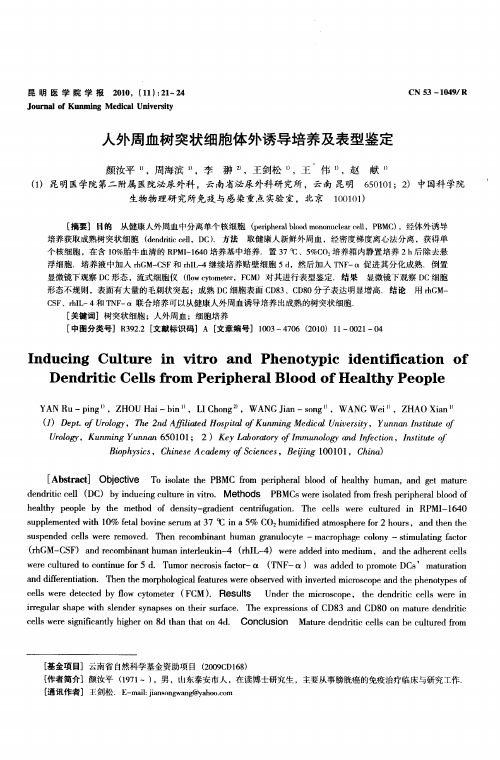
YAN Ru—pn ”, Z ig HOU Ha —bn”, L h n , W ANG Ja i i I og C in—sn ”, W ANG e ”, Z og W i HAO Xin a
()D p.f Uooy h n f l tdHo il K n n dcl n es y u n nIs tt o e to rl ,T e2 dAf i e s t u mi Me i i r t,Y n a tue f g i a p ao f g aU v i ni Uoo ,K n igY n a 5 1 1 2)K yL b rtr I muoo n f ci ,Is tt o rl y g u m n u n n6 0 0 ; e a oa yo m nl adI e t n ntu o f y g n o i ef Bo hs s hns d m & cs e ig1 0 0 ,C ia i yi ,C i eA a e yo S ne ,B in 0 1 1 hn ) p c e c f c j
昆 明 医 学 院 学 报
2 1 ,( 1 : 1 4 0 0 1 ) 2 —2
CN 3—1 9 R 5 Ol /
J u n lo n ig M e ia ie s y o r a fKu m n dc lUnv ri t
人外周 血树 突状细胞 体 外诱 导培 养及 表型 鉴定
( G C F adrcm iat u a t l kn 4 ( I一 ) w r d e t meim.a dte d eet e s r M— S ) n o bn n m ni e e i一 r L 4 ee ddi o du h e h n ru h a n n hrn l ha cl
树突状细胞的培养及成熟的鉴定_李望

树突状细胞的培养及成熟的鉴定李望,张升宁,冉江华,苏晓三,李来邦,陈奕明(昆明市第一人民医院肝胆胰一科,云南昆明650101)[摘要]目的探讨人体外周血树突状细胞在体外培养诱导其成熟的方法,通过得到成熟的细胞培养技术,对树突状细胞功能的研究奠定实验基础.方法通过Ficoll-Hypaque梯度离心法得到单个核细胞,再诱导使其分化、扩增、纯化形成稳定的树突状细胞,通过树突状细胞自身形态、特异性表型,抗原摄取能力,鉴别培养的细胞,从而得到具有典型特征的树突状细胞.结果树突状细胞培养第7天,加入LPS后,倒置显微镜及扫描电镜下观察,树突状细胞成熟中,细胞胞质增大,细胞膜表面能形成大量树突状突起,表面标志物CD80、CD86、CD11c、HLA-DR的表达增高(P<0.05),共聚焦显微镜下,成熟的树突状细胞对抗原的吞噬能力减弱.结论Ficoll-Hypaque梯度离心法能够得到稳定的树突状细胞体外培养体系.[关键词]Ficoll-Hypaque梯度离心法;树突状细胞;表型;抗原;吞噬[中图分类号]R392.12[文献标识码]A[文章编号]2095-610X(2015)03-0034-04TheCultivationandIndentificationofMatureDendriticCellsLIWang,ZHANGSheng-ning,RANJiang-hua,SUXiao-san,LILai-bang,CHENYi-ming(Dept.of Hepato-biliary-pancreatic Surgery ,The 1st People ’s Hospital of Kunming ,Kunming Yunnan650101,China )[Abstract]ObjectiveToexplorethemethodsofinducingandculturingdendriticcellsfromhumanperipheralbloodinvitro,inthepurposeofpreparingthefurtherexperimentforexploringthefunctionofdendriticcells(DCs).MethodsTheCD14+mononuclearcells(PBMC)wereobtainedbyFicoll-Hypaquegradientcentrifugation.ThestablematureDCswereharvestedbytheprocessofinduction,amplificationandpurification.ThetypicalDCswereidentifiedbyanalyzingthemorphology,phenotypeandfunction.ResultsThemorphologyofDCswasirregular,andplentyofradialdendritesfromcellbodieswereobservedundertheinvertmicroscopeandfluorescentmicroscopy.TheexpressionlevelsofCD83,CD80,CD86andHLR-DRwereincreasingasthematuratingofDCsaccordingtotheflowcytometertestingresults(P<0.05).TheantigenengulffunctionofimDCswasenhanced,whileitwasweakenedinmDCs.ConclusionTheisolatedandpurifiedimDCscouldbeinducedtoDCsbyFicoll-Hypaquegradientcentrifugation.[Keywords]Ficoll-Hypaquegradientcentrifugation;Denrditiccells;Phenotype;Antigen;PhagocytosisJournal of Kunming Medical UniversityCN 53-1221/R昆明医科大学学报2015,36(3):34~37[基金项目]云南省科技厅-昆明医科大学联合专项基金资助项目(2011FZ299)[作者简介]李望(1986~),男,湖南株洲市人,医学硕士,住院医师,主要从事肝胆外科临床及研究工作.[通讯作者]张升宁.E-mail:zsn813@163.com树突状细胞是机体内发现的具有最强专职抗原提呈细胞,因其在成熟过程中能伸出大量树突样突起而得名,人体树突状细胞起源于造血干细胞,外周血树突状细胞在数量上不足外周血单个核细胞的1%,它能摄取、加工处理抗原,并能将处理后的抗原递呈给T淋巴细胞.未成熟的树突状细胞具有较强的迁移能力及摄取、加工抗原能力,成熟的树突状细胞能有效激活初始型T淋巴细胞,并能启动、调控并维持免疫应答[1].1材料和方法1.1材料外周血细胞由健康、成人自愿捐献,淋巴细胞分离液(hycloneU.S.A),RPMI-1640培养液(eBioscience,U.S.A),重组人粒细胞-巨噬细胞集落刺激因子(RhGM-CSF)(eBioscience,U.S.A),重组人白介素4(rhIL-4)(eBioscience,U.S.A),脂多糖(LPS)(sigmaU.S.A),胎牛血清(hycloneU.S.A),PE-CD80(eBioscience,U.S.A),FITC-CD86(eBioscience,U.S.A),PE-CD11c(eBioscience,U.S.A),PE-5.5HLA-DR(eBioscience,U.S.A),OLYMPUS倒置显微镜(Olympus,Japan),微型扫描电镜(日立,TM1000),流式细胞仪(BeckmanCoulter),激光共聚焦显微镜(LeicaSP50).1.2实验方法1.2.1树突状细胞培养抽取空腹、健康成人外周血细胞,肝素抗凝,将细胞生理盐水稀释,加入淋巴细胞分离液离心分层,取第二层单个核层细胞层,37℃5%CO2培养箱中孵育2.5h,获取贴壁的单个核细胞层,经含rhGM-CSF(100ng/mL),rhIL-4(50ng/mL)的用RPMI-1640完全培养基孵育1d后,即得到未成熟的树突状细胞,诱导树突状细胞第6天用脂多糖(LPS)刺激产生成熟的树突状细胞.1.2.2树突状细胞形态学观察分别于树突状细胞培养第1天,第6天,第7天,倒置显微镜下观察树突状细胞形态的改变.收集培养7d的树突状细胞,经多聚赖氨酸沉淀于盖玻片上,用3%的戊二醛和1%饿酸固定,经乙醇梯度脱水,扫描电镜下观察树突状细胞形态.1.2.3细胞表型检测在2.0×105/mL的树突状细胞悬液中,分别加入CD80、CD86、CD11c、HLA-DR单抗,2h后,经PBS离心洗涤,加入抗原,45min后流式细胞检测.1.2.4分别于树突状细胞培养第6天及第7天,加入FITC-OVA抗原,37℃5%CO2培养箱中继续孵育1d,准备PE-CD11c荧光素标记的单克隆抗体于200μL的PBS,至期望浓度.单抗放置于冰上.低温保存,共聚焦显微镜下观察树突状细胞吞噬抗原能力.1.3统计学处理实验数据以均值±标准差(x±s)表示,数据处理应用SPSS软件包进行.流式细胞组间差异比较采用配对t检验,P<0.05为差异有统计学意义.2结果2.1倒置显微镜下观察树突状细胞的形态从倒置显微镜下可以看出,树突状细胞在培养第2天细胞呈均匀分布,形态单一,散在排列.晃动培养板可见随板晃动的细胞.在散在排列的细胞中,可分辨出呈团簇状排列的细胞团块.细胞培养第6天,加入LPS后,可见细胞较大,胞质丰富,悬浮的细胞,细胞膜表面分布许多分枝状突起,见图1.ABCD图1树突状细胞经分离、诱导、培养后不同时期树突状细胞的生长变化Fig.1ThedifferentperiodofDCsafterseparation,inductionandcultivationA:0d(200×);B:2d(400x);C:6d(400×);D:7d(400×).35第3期李望,等.树突状细胞的培养及成熟的鉴定表1树突状细胞成熟前后细胞表型阳性细胞数改变[%,(x ±s)]Tab.1ComparisonofphenotypeexpressionofDCsafterandbeforematuration[%,(x ±s)]树突状细胞CD11cCD80CD86HLA-DR加入LPS前37.0±1.517.0±1.117.2±0.954.2±0.4加入LPS后39.0±2.524.9±0.7*59.3±2.5*65.9±1.6*图2培养第7天树突状细胞(5000×)Fig.2ThemorphologyofDCsonthe7thdayafterculture(5000×)加入LPS后加入LPS前图3树突状细胞成熟前后细胞表型的变化Fig.3ComparisonofphenotypeofDCsafterandbeforematuration与加入LPS前比较,*P<0.05.2.2扫描电镜观察树突状细胞形态电镜下观察树突状细胞,细胞表面粗糙,有层叠状褶皱,细胞膜上分布大量外生的突起,见图2.2.3树突细胞表型变化加入LPS前后,树突状细胞表型有明显改变.CD80、CD86、HLA-DR在加入LPS前后,其细胞阳性表达率明显增加,差别都具有统计学意义(P<0.05),说明加入LPS后,树突状细胞共刺激分子CD80、CD86及MHC-II类分子的表达增加.而CD11c加入LPS前后,差别无统计学意义(P>0.05),提示LPS对CD11c无明显影响,见图3、图4及表1.2.4共聚焦显微镜下观察树突状细胞吞噬抗原能力图中细胞膜经PE-CD11c标记,共聚焦显微镜下呈红色荧光,抗原为FITC-OVA标记,共聚焦显微镜下呈绿色荧光,见图5.共聚焦显微镜下可看到经PE-CD11c标记的细胞膜,使细胞膜表面呈现红色荧光,并可辨别树突状细胞表面形态,树突状细胞表面不规则,有大量外生的树突状突起,细胞内可见FITC-OVA标记,呈现绿色荧光的抗原,在细胞内部均匀分布.加入LPS后,随树突状细胞的成熟,树突表面突起明显增加,但细胞对抗原的摄取明显减弱.第36卷36昆明医科大学学报图4树突状细胞成熟前后细胞表型的变化Fig.4ComparisonofphenotypeofDCsafterandbeforematuration加入LPS后加入LPS前图5示树突状细胞成熟前后抗原吞噬能力的比较(×800)Fig.5ComparisonofantigenengulffunctionofDCsafterandbeforematuration(×800)图中细胞膜经PE-CD11c标记,共聚焦显微镜下呈红色荧光,抗原为FITC-OVA标记,共聚焦显微镜下呈绿色荧光.37第3期李望,等.树突状细胞的培养及成熟的鉴定3讨论3.1从形态学上分析树突状细胞1973年Steinman首次发现树突状细胞,研究中发现树突状细胞在免疫应答机免疫耐受中占有重要地位,树突状细胞(dendriticcells,DC)广泛分布于脑以外的全身组织及器官,仅占人外周血单个核细胞的1%,因其具有许多分枝状突起故名,在倒置显微镜下[2],树突状细胞培养第1天,在IL-4及GM-CSF诱导下,细胞由散在、均匀排列的单加入LPS前加入LPS后加入LPS前加入LPS前加入LPS前加入LPS后加入LPS后加入LPS后独细胞,逐渐形成大量贴壁的细胞集落团块,细胞大小从整体上观察均匀一致,未见明显突起.而树突状细胞培养至第7天,加入LPS后,从培养液中可明显辨别出大量细胞质丰富,在细胞培养液中呈悬浮状态的树突状细胞,细胞膜表面呈现许多分枝状突起,细胞集落团块减少或消失.电镜下,观察树突状细胞,细胞较大,细胞表面粗糙,有大量外生型突起.本实验采用Ficoll-Hypaque梯度离心法,从外周血中分离出CD14+单个核细胞,根据树突状细胞短暂性贴壁的特性,分离出树突状细胞,极大简化实验分离过程,并且能够避免在间接贴壁中收集转移贴壁细胞对前体细胞的丢失,此实验方法在大多实验中得到证实[3,4].在CD14+细胞诱导成熟过程中,加入GM-CSF、IL-4,能使CD14+单个核细胞向未成熟的树突状细胞转化,GM-CSF是树突状细胞发育重要的细胞因子,能诱导单个核细胞形成细胞集落,并生产少量树突状细胞,IL-4的加入,能抑制中性粒细胞及巨噬细胞的产生,促进单核细胞向未成熟树突细胞转化[5],在试验中,倒置显微镜下观察的大量集落刺激单位形成相一致.脂多糖是革兰氏阴性细菌细胞壁中的一种成分,加入磷酸脂多糖(LPS)后,未成熟细胞摄取LPS,并与Toll样受体4结合,增强IFN的表达,从而导致未成熟树突细胞向成熟树突状细胞转化[6].3.2从表型上分析树突状细胞未成熟树突状细胞表面表达低水平的共刺激分子及MHL-II类分子,而高表达一系列受体,如Toll样受体、C型凝集素等,其形态与功能相适应,高表达的受体有利于未成熟细胞识别、摄取抗原相关的物质.一旦未成熟树突状细胞受到炎性刺激,未成熟细胞则会向成熟细胞转化,其中共刺激分子及MHL-II表达水平显著提高,其意义在提供T细胞活化的信号.如T细胞受体与MHC-抗原复合体结合传递信号,T细胞表型CD28与CD80/CD86结合传递信号,从而启动获得性免疫应答[7].实验中,树突状细胞LPS刺激后,CD80、CD83、CD86、HLA-DR的表型显著较刺激前表达增高,提示未成熟树突状细胞向成熟细胞转化,这种现象与理论相适应.实验中发现,CD11c在LPS刺激前后,都出现高表达现象,提示CD11c可能是树突状细胞共有表型,有待进一步研究证实.从抗原摄取能力分析树突状细胞未成熟树突细胞具有较强的抗原吞噬能力,抗原通过与树突状细胞Toll样受体结合,并通过内(下转第44页)发症和医疗意外;与其他行业相比,医务人员面对的是身有疾病的患者,其工作关系到病人的生命的安全,行业的特殊性要求他们必须要有更强的责任心,其职业行为必须更加严格规范.医院的各项医疗规章制度是对医务人员的基本要求,若不严格执行将给患者带来极大的安全隐患,也使医院和医务人员在面对纠纷时处于十分被动的境地.医疗纠纷虽然不可避免,但是通过医院管理者对其成因的分析,可以在一定的程度上防范医疗纠纷的发生.医院管理部门要不断修订和完善各类制度规范,还要加大宣传、教育和督导力度,提高医务人员的医疗水平和执行力,确保各项制度规范严格落实.只有这样才能有效的控制医疗纠纷的发生,才能为患者就医提供更加舒适、更加轻松的医疗环境.[参考文献][1]唐春爱.22477例出院病人疾病构成帕累托图分析[J].中国医院统计,2008,15(4):346-347.[2]李雅立.出院患者22459例次疾病构成帕累托图分析[J].中国冶金工业医学杂志,2011,28(6):630-631.[3]张涛.医疗纠纷的成因探讨[J].国际护理学杂志,2007,23(5):534-536.[4]宋会臻.难以避免的医疗意外与对策探讨[J].中国误诊学杂志,2007,7(9):2028-2029.(2015-01-03收稿)吞、胞饮等作用,将抗原摄取进入细胞内,进而完成对抗原的加工处理过程.同时进一步诱导树突状细胞成熟,成熟的树突状细胞对抗原的摄取、加工能力较弱,但能发挥抗原递呈作用,将处理的抗原,递呈给T淋巴细胞,同时通过一系列共刺激分子、细胞因子等作用,诱导T淋巴细胞活化.模式抗原卵白蛋白(OVA)有良好的免疫原性,是常用的半抗原载体,用用荧光标记的FITC-OVA抗原,能较好的反应树突细胞摄取、加工抗原吞噬能力,在共聚焦显微镜下观察细胞内OVA分布、密度状况,可作为树突状细胞成熟能力鉴别方法之一.目前对于人体树突状细胞研究已有大量报道,引起自身的特性,对树突状细胞的研究具有重要的临床意义.Giliet等早期发现,在人体血液及组织中有两种特怔性的树突状细胞组群:髓样树突状细胞(conventionalmyeloiddendriticcells,mDC)以及类浆细胞样树突状细胞(plasmacytoiddendriticcells,pDC),外周血中pDC的比例较mDC明显较高时,可诱导出现机体出现免疫耐受[8].在未来的发展趋势中,树突状细胞将在肿瘤、移植免疫等方面研究中发挥重要的作用.[参考文献][1]WALLETMA,SENP,TISCHR.Immunoregulationofden-driticcells[J].ClinMedRes,2005,3(3):166-175.[2]BANCHEREAUJ,STEINMANRM.Dendriticcellsandthecontrolofimmunity[J].Nature,1998,392(19):245-255.[3]高伟生,罗荣成,马树东,等.人外周血树突状细胞的分离与鉴定[J].中国组织工程研究与临床康复,2007,11(11):2105-2109.[4]陶晓根,莫宝定,陈剑,张蕾,等.健康人外周血树突状细胞体外培养及表型鉴定[J].临床和实验-医学杂志,2012,11(23):1837-1839.[5]BANCHEREAU.Immunobiologyofdendriticcells[J].AnnuRevImmunol,2000,18(4):767-811.[6]KAWAIT,AKIRAS.TLRsignaling[J].CellDeathDif-fer,2006,13(6):816-825.[7]REISESOUSA.Dendriticcellsinamatureage[J].NatRevImmunol,2006,6(6):476-483.[8]GILIETM,LIUYJ.GenerationofhumanCD8TregulatorycellsprimeIL-10producingTregulatorycellsbyinduciblecostimulatorligand[J].JExpMed,2007,204(15):105-161.(2015-01-13收稿)第36卷44昆明医科大学学报4444444444444444444444444444444444444444444444444444444444444444444444444444444444444444444444444(上接第37页码)。
人树突状细胞分离与鉴定最新研究进展
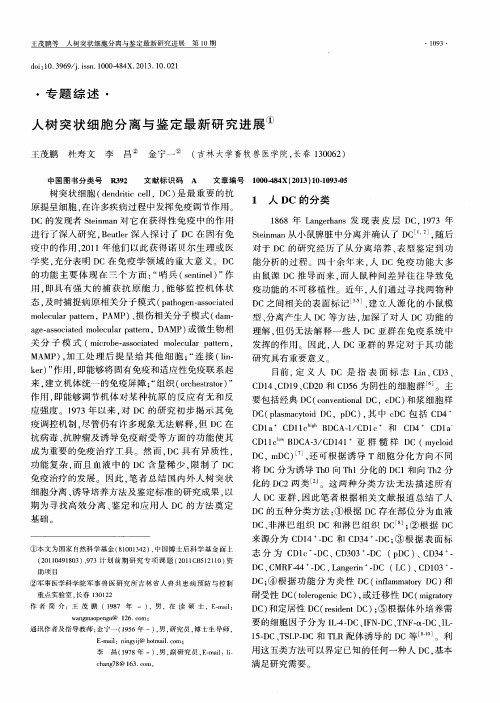
树 突状 细胞 ( d e n d r i t i c c e l l ,D C) 是 最 重要 的抗
原提 呈细 胞 . 在许 多疾 病过 程 中发 挥免 疫调 节作 用 。 D C的发 现 者 S t e i n ma n对 它在 获 得 性 免疫 中 的作 用
进行 了深 入 研 究 。 B e u t l e r 深人探讨 了 D C在 固有 免 疫 中的作 用 . 2 0 1 1年他 们 以此获 得 诺 贝尔 生理 或 医 学奖 , 充 分表 明 D C在免 疫 学 领 域 的重 大 意 义 。D C 的功 能 主 要 体 现 在 j 个 方 面 : “ 哨兵 ( s e n t i n e 1 ) ” 作
成 为重 要 的免 疫 治疗 工 具 。然 而 , D C具 有 异 质 性 , 功能复杂 , 而 且 血 液 中的 D C含 量 稀 少 . 限制 了 D C 免 疫治 疗 的发 展 。 因此 , 笔者 总结 国 内外 人 树 突 状 细 胞分 离 、 诱 导 培养 方法 及鉴 定标 准 的研 究成 果 , 以
型、 分 离产 生人 D C等方 法 , 加 深 了对人 D C功 能 的
理解 , 但 仍 无 法 解 释一 些 人 D C亚 群 在 免疫 系 统 中
a g e — a s s o c i a t e d m o l e c u l a r p a t t e r n , D A MP ) 或微 生 物相
能分 析 的过 程 。 四十余 年 来 , 人 D C免 疫 功 能 大 多
由鼠源 D C推 导 而来 . 而 人 鼠种 间差 异 往 往导 致 免 疫 功能 的不可 移 植性 。近 年 , 人 们 通 过 寻 找 两 物 种 D C之 间相 关 的表 面标 记 _ 3 、 建 立 人 源 化 的小 鼠模
尤文肉瘤细胞总RNA修饰的树突状细胞的体外培养及其鉴定
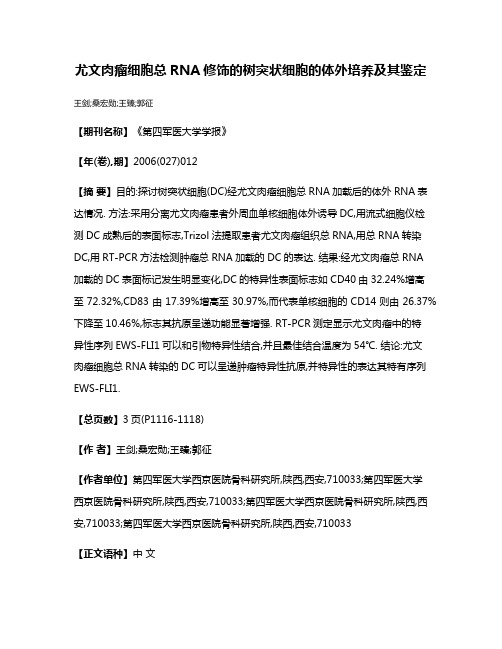
尤文肉瘤细胞总RNA修饰的树突状细胞的体外培养及其鉴定王剑;桑宏勋;王臻;郭征【期刊名称】《第四军医大学学报》【年(卷),期】2006(027)012【摘要】目的:探讨树突状细胞(DC)经尤文肉瘤细胞总RNA加载后的体外RNA表达情况. 方法:采用分离尤文肉瘤患者外周血单核细胞体外诱导DC,用流式细胞仪检测DC成熟后的表面标志,Trizol法提取患者尤文肉瘤组织总RNA,用总RNA转染DC,用RT-PCR方法检测肿瘤总RNA加载的DC的表达. 结果:经尤文肉瘤总RNA 加载的DC表面标记发生明显变化,DC的特异性表面标志如CD40由32.24%增高至72.32%,CD83由17.39%增高至30.97%,而代表单核细胞的CD14则由26.37%下降至10.46%,标志其抗原呈递功能显著增强. RT-PCR测定显示尤文肉瘤中的特异性序列EWS-FLI1可以和引物特异性结合,并且最佳结合温度为54℃. 结论:尤文肉瘤细胞总RNA转染的DC可以呈递肿瘤特异性抗原,并特异性的表达其特有序列EWS-FLI1.【总页数】3页(P1116-1118)【作者】王剑;桑宏勋;王臻;郭征【作者单位】第四军医大学西京医院骨科研究所,陕西,西安,710033;第四军医大学西京医院骨科研究所,陕西,西安,710033;第四军医大学西京医院骨科研究所,陕西,西安,710033;第四军医大学西京医院骨科研究所,陕西,西安,710033【正文语种】中文【中图分类】R392.12【相关文献】1.少量人外周血体外培养鉴定单核细胞来源树突状细胞方法初探 [J], 陈静思;王华;罗晓燕2.小鼠肝癌总RNA转染的树突状细胞体外诱导特异性细胞毒T淋巴细胞的研究[J], 王国强;钟翠平;傅继东;范强;张新华;吴超群;顾云娣3.人肝癌细胞总RNA电转染树突状细胞对T细胞的激活效应 [J], 单铁英;苏安英;唐军民4.转染肿瘤细胞总RNA的树突状细胞联合CIK细胞抗小鼠肝癌作用的实验研究[J], 罗善超;刘剑勇;赵荫农;张志明;崔英;张春燕;张力图5.尤文肉瘤细胞总RNA转染的DC疫苗体外诱导尤文肉瘤患者特异性抗肿瘤免疫的实验研究 [J], 王剑;桑宏勋;王臻;郭征因版权原因,仅展示原文概要,查看原文内容请购买。
- 1、下载文档前请自行甄别文档内容的完整性,平台不提供额外的编辑、内容补充、找答案等附加服务。
- 2、"仅部分预览"的文档,不可在线预览部分如存在完整性等问题,可反馈申请退款(可完整预览的文档不适用该条件!)。
- 3、如文档侵犯您的权益,请联系客服反馈,我们会尽快为您处理(人工客服工作时间:9:00-18:30)。
树突状细胞的培养与鉴定【摘要】目的研究利用磁珠分离方法获取单核细胞,用细胞因子gm-csf和il-4联合诱导使之分化为树突状细胞(dendritic cells, dcs)的方法,并对培养的细胞从形态,表型,功能等三个方面进行鉴定,从而探索出一套较成熟的dcs的培养方法。
方法通过密度梯度离心的方法获取白细胞悬液中的白膜层,然后通过磁珠分离的方法,收集高纯度的单核细胞。
在细胞因子gm-csf和il-4的刺激下,将细胞培养至7天左右,收集细胞进行流式分析,并进行淋巴细胞增殖实验,鉴定细胞是否为树突状细胞。
结果在倒置显微镜下观察,细胞培养第7天,大部分细胞呈单个悬浮,并有明显的毛刺样突起。
流式分析发现细胞高表达dc表面特异性抗原cd80,cd86,hla-dr,并且不再表达单核细胞表面抗原cd14,细胞纯度约为93.12%。
淋巴细胞增殖实验显示dcs可明显刺激初始型淋巴细胞增殖。
结论通过磁珠分离的方法获得单核细胞并利用gm-csf和il-4细胞因子诱导可成功培养出纯度高的树突状细胞。
【关键词】树突状细胞;磁珠;流式molecular and functional characteristics of dendritic cells differentiated from highly purified blood monocytes. 【abstract】 objectives:to develop a simple and efficient method to generate human dendritic cells (dcs) from highly purified cd14 + monocytes from human peripheral blood. methods:monocytes were purified by negatively sortingperipheral blood mononuclear cells (pbmc) with dynal magnetic negative isolation kit. monocytes were then differentiated into immature dendritic cells stimulated by the combination of interleukin-4 (il-4) and granulocyte-macrophagecolony-stimulating factors (gm-csf) for 7days. cells were analyzed for phenotype by flow cytometry。
allogenic lymphocyte proliferation assay was done by mixing dendritic cells with nave cord blood mononuclear cells and then coculture for 4 days. results:upon culture with gm-csf plus il-4, cd14+ cells rapidly became non-adherent clustered, developed into a morphologically homogeneous cell population with different extents of veiled morphology. analysis of surface markers showed that the cells became cd14- and expressed high levels of hla-dr、cd80、cd86, and cd40. cells showed high capacity of stimulating nave lymphocytes to proliferate. conclusions: facs analysis and functional capacity identified the cells with typical veils as dendritic cells.【key words】 dendritic cell, magnetic, flow cytometry 树突状细胞(dendritic cells, dcs)是免疫系统中强有力的免疫调控细胞(banchereau,1998)。
随着树突状细胞在基因治疗及免疫治疗的应用,以及人们对免疫反应机制的不断探索研究,树突状细胞的分离、纯化、培养与鉴定技术也得到了飞速的发展。
目前国内实验室在如何在体外培养出高质量的dcs的技术依然很欠缺。
本研究在国外一些研究的基础上,经过改进探索了一套较成熟、简单、高效的培养树突状细胞的方法,并通过细胞形态、表型、功能等方面鉴定细胞为树突状细胞,为今后这方面的实验研究提供一条可供选择的技术方法。
1 材料与方法1.1 树突状细胞的培养取20ml左右的新鲜分离的白细胞悬液(武汉市中心血站),与pbs(ph=7.2)等体积混合,利用ficoll-paque plus (amersham biosciences)密度梯度离心分离得到单个核细胞,约3×107/ml,利用dynal单核细胞磁珠分离试剂盒(dynal biotech),得到高纯度单核细胞,重悬于加入20%fcs(gibco)的rpmi-1640 (gibco)培养基中,调整密度至5×105/ml,接种六孔板中(bd corporation),加入rhgm-csf (r&d)终浓度50ng/ml, il-4(r&d)终浓度20ng/ml,隔天半量换液,37℃5%co2,培养至5天左右,加入tnf-α100ng/ml(peprotech),培养第7-8天收获悬浮细胞。
1.2 流式细胞术分析单核细胞和树突状细胞的表型收集磁珠分选后的细胞悬液,调整细胞密度并分别加入20μl pe –mouse igg1k isotype control以及pe-anti human cd14抗体,4℃避光孵育45min,pbs洗涤两次,1%多聚甲醛固定,流式细胞仪分析。
收集培养至7-8天左右细胞,分别加入pe标记的鼠抗人cd14,抗人hla-dr,抗人cd80,抗人cd86单克隆抗体(ebioscience),pe标记的鼠的同型对照抗体, 4℃避光孵育45min后,pbs洗两次,1%多聚甲醛固定,流式细胞仪检测细胞表型。
1.3 淋巴细胞增殖反应收集新生儿脐带血,利用ficoll-paque plus密度梯度离心的方法获得新生儿单个核细胞。
将培养至7天的树突状细胞用完全培养基悬浮后密度为1×105细胞/ml,加入丝裂霉素c25μg/ml,37℃孵育45分钟,pbs洗3次,用完全培养基再次悬浮,以3×104/孔, 1.5×104/孔,7.5×103/孔,3.75×103/孔,1.875×103/孔, 9.375×102/孔,2.35×102/孔密度加入96孔圆底培养板,每个浓度设置3个孔,加反应细胞即方法相同新生儿单个核细胞悬液,5×104/ml,100μl/孔。
37℃5%co2浓培养4天,每孔加入5mg/ml的mtt10μl,继续培养4h,离心,甩去上清,加入dmso150μl/孔,轻轻振荡,待结晶完全溶解10min,酶联免疫检测仪于570nm处检测并记录结果,同时设有空白对照。
2 结果2.1 单核细胞的分离与树突状细胞的培养倒置显微镜下观察,磁珠分离得到的单核细胞圆形均质,悬浮,细胞纯度大于90%。
在加入细胞因子gm-csf和il-4后,细胞培养第二天可见悬浮的细胞簇。
培养第3-4天,可见部分细胞出现毛刺样的突起,培养至第7天,大部分细胞呈单个悬浮,并有明显的毛刺样突起,如图1所示。
图一:典型的树突状细胞(×40)2.2 细胞表型流式细胞仪对新鲜分离的单核细胞以及培养至第7天的树突状细胞表面抗原进行分析,检测细胞表面cd14、cd80、cd86、hla-dr等分子的表达情况。
结果显示新鲜分离的单核细胞高表达细胞抗原cd14,而培养至第7天的树突状细胞表面出现特异性抗原cd1a、cd80、cd86、hla-dr, 而不再表达单核细胞抗原cd14,结果如图二所示。
2.3 淋巴细胞增殖反应新生儿脐带血中含有大量的初始型t淋巴细胞,仅树突状细胞可以刺激初始型t淋巴细胞增殖(sallusto,1994)。
细胞在树突状细胞作用4天后,数量明显增加(如图三所示).3 讨论抗原递呈细胞始动和调节免疫反应的发生,尤其是dcs在针对外来抗原的初始免疫反应中发挥关键作用(banchereau,1998;sumida,2004)。
越来越多的研究显示dcs由于表皮lc细胞的分离培养过程复杂,细胞数量有限,而血液中的dcs含量也极少,直接分离存在很大困难。
因此,我们采用分离dcs前体细胞即单核细胞的方法,在细胞因子诱导下培养dcs,这一方法操作相对简便,技术较成熟,且细胞保持体内未成熟dcs摄取加工抗原的特性,具有典型的突起,高表达mhcⅰ和mhcⅱ分子。
研究表明,从单核细胞诱导分化而来的dcs主要具备以下特点(salluato f,1994):1)典型的细胞形态和细胞的活动性;2)细胞的表型,高表达cd1、mhc-ⅰ、mhc-ⅱ、ii、fcμrⅱ、b7、cd40、icam-1、lfa-3、cd11c;3) 刺激初始型t细胞增殖能力强,dcs是唯一可以激活脐带血t细胞增殖的抗原递呈细胞。
因此,对树突状细胞的鉴定主要从这三个方面来进行。
经gm-csf、il-4共同培养的dcs是高度同质性的一群细胞,细胞的大小,形态,表型高度一致,方便实验研究,但是体外培养的dcs与体内的dcs还是具有这明显的差别。
研究发现,体外培养的dc具有mpo蛋白,并表达lz和m-csfr。
但这些标志并不经常在体内的dcs如朗格汉斯细胞及淋巴系dc检测到(pickl,1996),并且有实验证实皮肤dcs即lcs从体内分离后,短时间体外培养,表型会发生明显改变(victor,2001)。
另外,细胞因子的质量在dcs 培养过程中作用尤其重要,rd公司的细胞因子质量最好,有研究表明rd公司的il-4浓度为5ng/ml就可诱导单核细胞分化。
本研究经过多次实验发现gm-csf终浓度50ng/ml,il-4终浓度25ng/ml可起到较好的效果。
